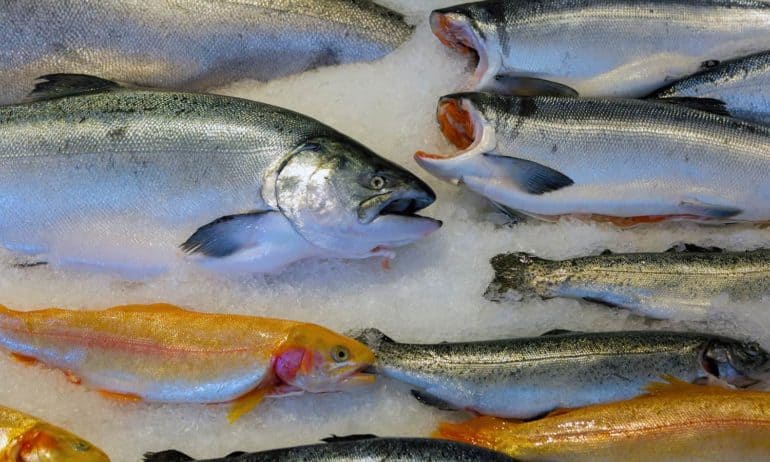There’s a totem pole on the grounds of the Sitka, Alaska, community health center. It includes traditional Native Alaskan images like the raven, but also carvings of a shaman and medicine woman to heal the people of alcoholism, substance abuse, and diabetes. No need to overstate these threats, which now include climate change and overfishing, with reams of statistics. They are easily discernible in the medicine woman down whose cheek falls a tear.
I learned more about the cause of her sadness during a week in Sitka, which is more than 850 miles from Seattle and one of the most expensive places in the U.S. to buy food. I learned that small things like herring roe matter, and big things like food, cannot be taken for granted. Its 9,000 people depend on weekly barge deliveries by sea for their food, and food insecurity and “subsistence” foods like salmon, herring roe, deer, and beach asparagus take on profound meanings.
Subsistence foods are necessary to keep a lid on food costs. Based on a food survey by the Sitka Local Foods Network, 48 percent of Sitkans hunt and fish, another 24 percent receive subsistence food as gifts or donations, and 57 percent eat fish or game several times a week. But for Tlingit and other Native people who comprise the 4,000 citizens of the Sitka Tribe (2,500 live in Sitka), subsistence foods are also an integral part of their cultural tradition. The land and waters surrounding them are the provenance not only of the Tribe’s sustenance, but also its soul and spirit. Unfortunately, the same survey revealed that 60 percent of the Tribe were not able to consume as much traditional food as they want.
One challenge is the US$5 billion Alaska seafood industry that is meeting the growing worldwide demand for fish protein. In some years, such as this one, the salmon runs are low and the herring spawn is severely diminished. Without those foods Native culture is weakened and health is at risk. Compared to non-Hispanic white people, for instance, American Indians and Alaska Natives are 2.3 times more likely to have diagnosed diabetes.
On my way into the Sitka Tribe’s administrative building I pass a totem pole with a woman’s face framed by two salmon. I’m here to meet with Jeff Feldpausch, the director of the Tribe’s Natural Resources Department, who has worked for the Tribe for 14 years running their traditional food program.
“We’ve seen a decline in the wild catch, not just for us, but across the board for all harvesters,” Jeff tells me. His frustration with the Alaska Board of Fisheries, which has responsibility for setting catch limits, is evident. “We’ve exhausted all our avenues. We’re considering other approaches.” He declined to tell me what they were, presumably not to tip the Tribe’s hand.
As much as the Tribe advocates for their subsistence food needs, they do what they can to harvest food for their people. Over the past year, Jeff’s staff has gathered 20,000 pounds (nearly 9,100 kilograms) of game and seafood that is distributed to the Tribe’s elders, an amount that falls far short of the Tribe’s needs.
One irony is that subsistence food is only 1 percent of the entire wild harvest with 98 percent going to commercial harvesters. In the words of Nicolaas Mink of the CSA-like Sitka Salmon Shares and natural resources professor at Knox College, Alaska’s fisheries are part of a “colonial food system because most of the catch is going to Asia.”
One small item that threatens to turn up the heat between the Tribe and state is the lowly herring and its roe. According to Jeff, “herring is a critical forage fish for our marine ecosystem, but right now we’re seeing the worst herring roe year since 2002. The elders don’t remember seeing such limited spawning.”
Based on a Portland State University ethnographic study of nearly 200 Tribal members with “local and traditional knowledge of herring populations,” present herring stocks are being managed in a “depleted status” that represents a fraction of their historical abundance. It concluded that lower rates of herring and roe threaten “biodiversity and regional marine food webs” and the cultural life of the region’s Native people. One interviewee, Harold Marin, said, “Herring are just so important to the total food chain…. [W]e didn’t like the idea of commercial fisherman… taking them on a large scale.”
Jeff told me that the Tribe put forward several proposals to the Alaska Board of Fisheries to reduce the pressure on the annual herring run. They were rejected, a response he characterized as “managing the resource for the market, not for conservation.” In light of climate change, it’s imperative that marine resources be managed more conservatively. “Something is changing out there [in the ocean] and we need to be more flexible to ensure subsistence harvesters can meet their needs.”
Whether herring roe are the proverbial canary in the coal mine signaling an imminent catastrophe is not certain. But a signal we must heed is the one from Native people who live closer to the earth and animals than we do. They are them because their culture and food depend on them. If the Tlingit are worried, then we should be too. The tear in the medicine woman’s eye may not only be for her own people, it may be for everyone.













